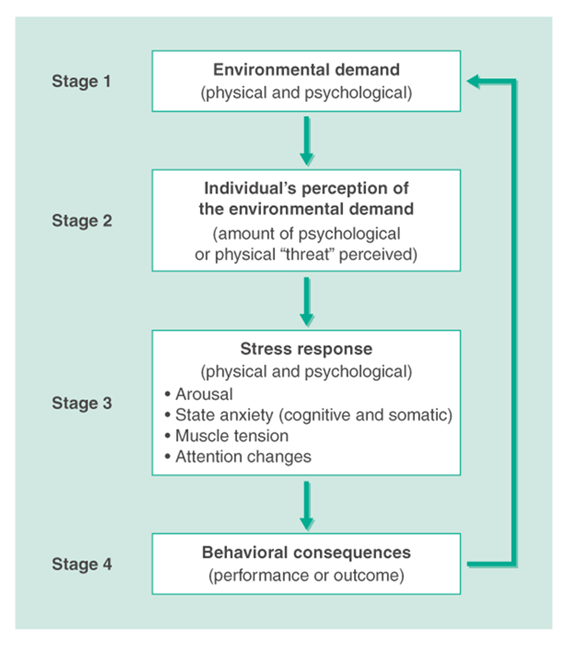Question
Managing Stress in Sport How do you deal with stress and stay calm under pressure? Imagine you are coaching a high school basketball team. How
Managing Stress in Sport
How do you deal with stress and stay calm under pressure? Imagine you are coaching a high school basketball team. How might you feel stress? What thoughts or physical stress responses do you experience, and how would you deal with them? How could learning how to manage stress be helpful to you and the players on the team?
- Try applying the 4-stage stress process to describewhyyou feel stressed
- Identify how you can interveneat each stageto manage your stress!
Cognitive and Somatic Anxiety
You are an athletic trainer working with an athlete who is complet-ing rehab and getting ready to return to activity. The athlete is clearly anxious about returning to play. How might the athlete be experiencing cognitive anxiety (what is the athlete thinking or worried about)? How might the athlete be experiencing somatic (physi-cal) anxiety? How might cognitive and somatic anxiety affect the athlete's return to activity? As the athletic trainer, how might you work with the anxious athlete?
Psych Up or Calm Down?
Consider the drive and inverted-U models of arousal-performance as well as Hanin's IZOF. Would you use psych-up or calm-down approaches if you were coaching a high school volleyball team? How would your approaches differ with an experienced senior team favored to win their state championship compared with an inexperienced freshman team?
Shaun White had fairly high levels of reinjury anxiety. And if you remember, his stress about reinjury greatly affected his training abilities and achievement behavior. Knowing what you know now about stress, how would you help Shaun White manage it?
- Apply the 4 stage stress process
- Identify interventions for each stage
- How do you know the interventions you proposed will work?
Coping With Injury As an athletic trainer, you would be likely to encounter athletes coping with injuries in many ways. List examples of both
emotion-focused and problem-focused cop-ing strategies, as well as avoidance coping, that injured athletes might use. Be specific and note both effective strategies and strategies that are less likely to be effective.
Adding Breathing Techniques to Exercise Sessions
Participants in an exercise class often bring wor-ries and muscle tension with them to class. As an exercise instructor, how could you incor-porate breathing exercises into your exercise class? Provide guidelines to help participants use these techniques in class and in their daily lives.

Stage 1 Stage 2 Stage 3 Environmental demand (physical and psychological) Individual's perception of the environmental demand (amount of psychological or physical "threat" perceived) Stress response (physical and psychological) Arousal State anxiety (cognitive and somatic) Muscle tension Attention changes Stage 4 Behavioral consequences (performance or outcome)
Step by Step Solution
There are 3 Steps involved in it
Step: 1
Question 1 1a Stressor Identification Its important to identify specific stressors in the coaching environment These could include High expectations from the school administration parents or the commu...
Get Instant Access to Expert-Tailored Solutions
See step-by-step solutions with expert insights and AI powered tools for academic success
Step: 2

Step: 3

Document Format ( 2 attachments)
663d89556e10a_965709.pdf
180 KBs PDF File
663d89556e10a_965709.docx
120 KBs Word File
Ace Your Homework with AI
Get the answers you need in no time with our AI-driven, step-by-step assistance
Get Started


